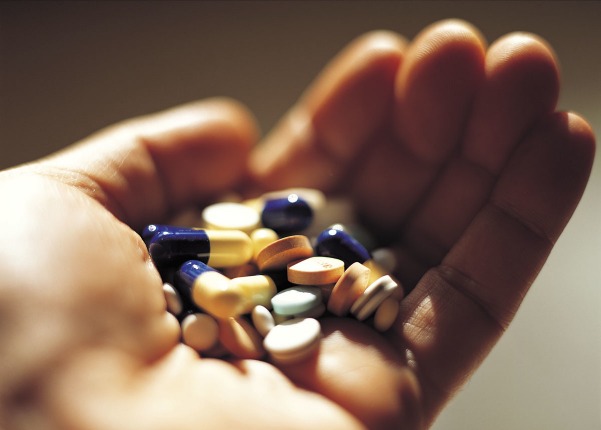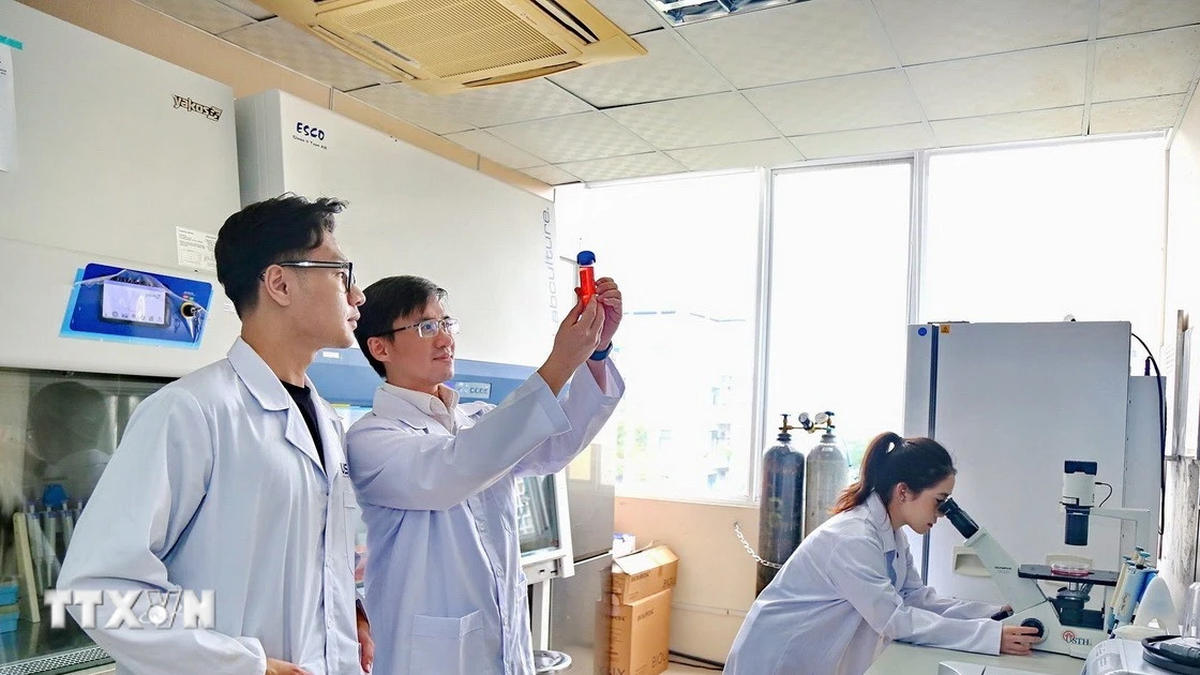Many patients stop taking their medications because they have to take many different medications throughout their long-term treatment, sometimes for life. However, many people do not realize that stopping taking their medications on their own will only make their condition worse.
Medical news on February 17: Risk of death due to arbitrarily stopping taking medication
Many patients stop taking their medications because they have to take many different medications throughout their long-term treatment, sometimes for life. However, many people do not realize that stopping taking their medications on their own will only make their condition worse.
Risk of death due to arbitrarily stopping taking medication
Recently, the Central Hospital for Tropical Diseases admitted patient LVT (51 years old, Hai Phong ) with severe jaundice and acute liver failure.
According to his medical history, Mr. T. was diagnosed with chronic hepatitis B two years ago and was prescribed antiviral drugs to control the disease. However, the patient did not comply with the treatment, did not take the medication regularly, and especially stopped taking the medication on his own more than a month before being hospitalized.
 |
| Illustration photo. |
After about two weeks of stopping the medication, the patient began to feel tired, had a loss of appetite, felt full, and was afraid of fat, but did not go to the doctor. By the third week, Mr. T had obvious jaundice, dark urine, pale stools, and a distended abdomen due to ascites.
During the fourth week, the patient developed generalized edema, subcutaneous hemorrhage, decreased consciousness, and slow response. Despite two rounds of hemodialysis and plasmapheresis at the previous medical facility, the patient’s condition did not improve. Finally, the patient was transferred to the Hepatitis Department, Central Hospital for Tropical Diseases for further treatment.
At the hospital, the patient was diagnosed with acute liver failure, cirrhosis, chronic hepatitis B, grade 2 hepatic coma, and was at risk of rapidly progressing to grade 3-4 if not controlled promptly. In addition, the patient also showed signs of kidney failure due to hepatorenal syndrome with creatinine levels increasing by more than 50% compared to normal and urine output decreasing sharply.
Dr. Doi Ngoc Anh, Department of Hepatitis, Central Hospital for Tropical Diseases said: "Hepatitis B is the main cause of cirrhosis and liver cancer.
Many patients think that when taking antiviral drugs, they will not be at risk of liver cancer, but in fact, even when treated, this risk still exists. In particular, when stopping the drug, the virus can flare up rapidly, causing cirrhosis and liver cancer to progress more quickly. If the patient does not respond to medical treatment, he or she may need a liver transplant to sustain life."
Many hospitals have also admitted patients in serious condition due to arbitrarily stopping Western medicine and seeking traditional oriental medicine of unknown origin.
Currently, there are many traditional oriental medicines advertised widely on the internet, but most of them are unlicensed, have no quality control and are of unknown origin. Therefore, patients need to be persistent, follow the treatment regimen of a specialist and absolutely do not use drugs of unknown origin, to avoid missing the "golden time" for treatment.
Arbitrarily combining Eastern and Western medicine without a doctor's prescription can cause dangerous drug interactions, making the condition worse.
In addition, chronic diseases such as diabetes, cardiovascular disease, hypertension... if treatment is stopped, will also be life-threatening. For infectious diseases such as tuberculosis, hepatitis B or C, if the treatment regimen is not strictly followed, the disease cannot be completely cured or will relapse, even causing drug resistance.
Many patients give up on their medications because they have to take multiple medications over the course of a long-term, sometimes lifelong, treatment. This can leave them feeling tired and discouraged, especially when they feel better.
Some people are afraid of the side effects of Western medicine, while others are too busy with work and cannot maintain a regular medication routine. In addition, the cost of treatment is also a factor that causes patients to not comply with the treatment regimen.
Medical experts warn that in the treatment of chronic diseases, it is very important to strictly follow the doctor's instructions and have regular check-ups to prevent the disease from recurring. Do not stop taking medication on your own when you feel better, as this can lead to serious consequences.
To limit the situation of abandoning treatment, patients need to have an optimistic spirit and a high awareness in complying with the treatment regimen. In addition, support from family, doctors and medical staff is also very important in the treatment process. The synchronous coordination between these factors will help patients achieve the best treatment results.
Towards ending the HIV/AIDS epidemic by 2030
The year 2025 will mark an important turning point in Vietnam's HIV/AIDS prevention and control strategy, aiming to end the epidemic by 2030, according to the National Strategy for HIV/AIDS Prevention and Control to 2020, with a vision to 2030.
Associate Professor, Dr. Phan Thi Thu Huong, Director of the Department of HIV/AIDS Prevention and Control ( Ministry of Health ) said that the goal of the national strategy by 2030 is to achieve the United Nations' vision of "three zeros": no new HIV infections, no AIDS deaths, and no stigma and discrimination against people with HIV/AIDS.
Over the years, the Ministry of Health has implemented many measures to prevent exposure, while flexibly coordinating ARV (antiretroviral) treatment, helping to improve the quality of life for people living with HIV and significantly reduce the risk of transmission.
According to statistics from the Department of HIV/AIDS Prevention and Control, there are currently more than 267,000 people infected with HIV in Vietnam. Notably, in 2024, both the number of new infections and the number of deaths decreased compared to 2023.
To date, HIV testing has been implemented in 50/63 provinces and cities, with more than 1,300 screening laboratories and 251 HIV confirmation laboratories nationwide. Medical facilities from central to local levels are involved in testing and treatment.
As of mid-2024, nationwide, 181,558 people infected with HIV were treated with ARV drugs, including 2,466 children under 15 years old.
ARV treatment is now available at more than 500 medical facilities nationwide. Although Vietnam is highly regarded in the region and the world for its HIV/AIDS treatment and prevention, there are still about 70,000 people living with HIV who have not received ARV treatment, of which about 40,000 people know their infection status but have not yet participated in treatment, and about 30,000 people do not know their status.
Vietnam is currently facing a number of major challenges in the fight against HIV/AIDS. The HIV epidemic is concentrated among high-risk groups such as injecting drug users, men who have sex with men, and female sex workers. The 15-29 and 30-39 age groups account for the highest rates of HIV infection, with the majority of infections transmitted through sexual contact and blood.
One of the serious problems is that people with HIV still face stigma and discrimination from society, making it difficult for them to access medical services and job opportunities.
Geographically, the HIV epidemic is mainly concentrated in the Mekong Delta, Ho Chi Minh City and the Southeast, accounting for nearly 70% of new infections. However, in recent years, the Northern mountainous areas and the Central Highlands have been at risk of increasing HIV infections.
Vietnam has implemented many models of providing HIV testing and counselling services at health facilities, in the community and through online services. Prevention measures such as "K=K" (undetected = untransmitted) and ARV treatment combined with treatment for co-infection with hepatitis C and non-communicable diseases are being widely implemented, ensuring a people-centred approach to treatment.
31-year-old man suddenly paralyzed on one side, difficulty speaking due to stroke
Phu Tho General Hospital has just received and treated a 31-year-old male patient from Phu Tho who suffered a stroke due to acute cerebral infarction. Upon admission, the patient showed symptoms of complete paralysis of the right side of his body and difficulty speaking. He had no history of any chronic diseases.
Immediately, the patient was examined by doctors at the Stroke Center and underwent a digital subtraction angiogram. The results showed that he had a blockage in the left internal carotid artery, and the doctors ordered a thrombolytic intervention. After about 20 minutes of intervention, the team of doctors removed 6 pieces of 2x2mm blood clots, helping to re-open the cerebral blood vessels.
One day after the intervention, the patient was alert, had improved movement in the right arm and leg, and continued to receive rehabilitation treatment, along with screening for stroke risk factors. In addition, doctors also provided a monitoring and preventive treatment strategy to prevent stroke recurrence.
According to MSc. Dr. Hoang Quoc Viet, Deputy Head of the Department of Emergency and Intensive Care for Neurology and Stroke at the Stroke Center, Phu Tho General Hospital, the number of severe stroke patients and their younger age has increased recently. At the center, the proportion of patients aged 18 to 45 has doubled compared to previous years.
Risk factors for stroke in young people may be related to immune and genetic diseases, as well as lifestyle factors. Factors such as the use of birth control pills, substance abuse, alcohol, tobacco, overweight, obesity, lack of exercise, staying up late, and stress in life or work can all increase the risk of stroke.
A notable issue is that many young people are often subjective, thinking that they are still healthy and do not need regular health check-ups. Therefore, only when a stroke occurs do they discover that they have underlying diseases such as high blood pressure or cardiovascular disease.
When suffering a stroke, it is extremely important to receive emergency care within the “golden hour” (the first 4.5 hours after symptoms appear). If not treated promptly, the patient’s chances of recovery will be very difficult, and many people may face disability, loss of self-care ability, or loss of ability to work.
Although anyone can have a stroke, some people are at higher risk than others. Being aware of the risk factors and detecting warning signs early is important for proactive prevention.
Stroke symptoms to watch out for include difficulty speaking and understanding: People having a stroke may experience confusion, slurred speech, or an inability to understand what others are saying.
Numbness, weakness, or paralysis on one side of the body: Usually affects the face, arm, or leg on one side. If you try to raise your arms, the paralyzed arm may fall. One side of your mouth may droop when you try to smile.
Vision problems: Blurred or double vision, which can occur suddenly in one or both eyes. Severe headache: Sudden and severe headache, which may be accompanied by vomiting, dizziness, or altered consciousness. Difficulty walking: The patient may lose balance, stumble, or have difficulty coordinating movements.
Source: https://baodautu.vn/tin-moi-y-te-ngay-172-nguy-co-tu-vong-do-tu-y-ngung-dung-thuoc-dieu-tri-d247152.html




































































































Comment (0)